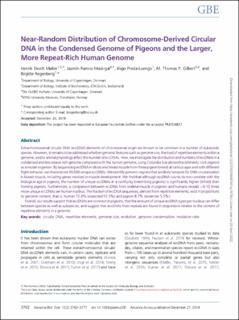| dc.contributor.author | Møller, Henrik Devitt | |
| dc.contributor.author | Ramos-Madrigal, Jazmín | |
| dc.contributor.author | Prada-Luengo, Iñigo | |
| dc.contributor.author | Gilbert, Marcus Thomas Pius | |
| dc.contributor.author | Regenberg, Birgitte | |
| dc.date.accessioned | 2022-05-04T10:22:56Z | |
| dc.date.available | 2022-05-04T10:22:56Z | |
| dc.date.created | 2020-10-07T15:11:53Z | |
| dc.date.issued | 2020 | |
| dc.identifier.citation | Genome Biology and Evolution (GBE). 2020, 12 (2), 3762-3777. | en_US |
| dc.identifier.issn | 1759-6653 | |
| dc.identifier.uri | https://hdl.handle.net/11250/2994118 | |
| dc.description.abstract | Extrachromosomal circular DNA (eccDNA) elements of chromosomal origin are known to be common in a number of eukaryotic species. However, it remains to be addressed whether genomic features such as genome size, the load of repetitive elements within a genome, and/or animal physiology affect the number of eccDNAs. Here, we investigate the distribution and numbers of eccDNAs in a condensed and less repeat-rich genome compared with the human genome, using Columba livia domestica (domestic rock pigeon) as a model organism. By sequencing eccDNA in blood and breast muscle from three pigeon breeds at various ages and with different flight behavior, we characterize 30,000 unique eccDNAs. We identify genomic regions that are likely hotspots for DNA circularization in breast muscle, including genes involved in muscle development. We find that although eccDNA counts do not correlate with the biological age in pigeons, the number of unique eccDNAs in a nonflying breed (king pigeons) is significantly higher (9-fold) than homing pigeons. Furthermore, a comparison between eccDNA from skeletal muscle in pigeons and humans reveals ∼9-10 times more unique eccDNAs per human nucleus. The fraction of eccDNA sequences, derived from repetitive elements, exist in proportions to genome content, that is, human 72.4% (expected 52.5%) and pigeon 8.7% (expected 5.5%).
Overall, our results support that eccDNAs are common in pigeons, that the amount of unique eccDNA types per nucleus can differ between species as well as subspecies, and suggest that eccDNAs from repeats are found in proportions relative to the content of repetitive elements in a genome. | en_US |
| dc.language.iso | eng | en_US |
| dc.publisher | Oxford University Press | en_US |
| dc.rights | Navngivelse 4.0 Internasjonal | * |
| dc.rights.uri | http://creativecommons.org/licenses/by/4.0/deed.no | * |
| dc.title | Near-Random Distribution of Chromosome-Derived Circular DNA in the Condensed Genome of Pigeons and the Larger, More Repeat-Rich Human Genome | en_US |
| dc.title.alternative | Near-Random Distribution of Chromosome-Derived Circular DNA in the Condensed Genome of Pigeons and the Larger, More Repeat-Rich Human Genome | en_US |
| dc.type | Peer reviewed | en_US |
| dc.type | Journal article | en_US |
| dc.description.version | publishedVersion | en_US |
| dc.source.pagenumber | 3762-3777 | en_US |
| dc.source.volume | 12 | en_US |
| dc.source.journal | Genome Biology and Evolution (GBE) | en_US |
| dc.source.issue | 2 | en_US |
| dc.identifier.doi | 10.1093/gbe/evz281 | |
| dc.identifier.cristin | 1837978 | |
| cristin.ispublished | true | |
| cristin.fulltext | original | |
| cristin.qualitycode | 2 | |

